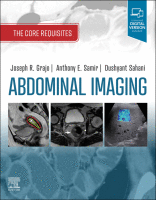Physical Address
304 North Cardinal St.
Dorchester Center, MA 02124

Anatomic variants ◼ Accessory spleen: very common. Typically near spleen. Can be intrapancreatic. Can be mistaken for a mass. Should look like spleen on all imaging sequences. ◼ Duplicated renal collecting system: prone to obstruct Has surgical implications. ◼ Prominent…

Anatomy, embryology, pathophysiology ◼ Injuries depend upon patient composition, blunt versus penetrating injury, mechanism of injury, and strength of forces. ◼ Blunt trauma etiologies: motor vehicle crash, falls, assault, and sports resulting in deceleration/shear forces, crushing forces, and increased intraabdominal…

Techniques Plain radiography Plain radiographs are often used in the postoperative abdomen to evaluate lines and tubes, bowel gas pattern, retained foreign bodies, and the presence of pneumoperitoneum. Fluoroscopy Fluoroscopic upper gastrointestinal (GI) examination with water-soluble or barium enteric contrast…

Anatomy, embryology, pathophysiology ◼ The pelvic floor consists of the levator ani, the pelvic sphincters, and fascia that support the rectum, bladder and urethra, as well as the vagina, cervix, and uterus in females and the prostate in males. ◼…

Anatomy, embryology, pathophysiology ◼ After the sixth week of gestation, in the absence of a Y chromosome, the paired Müllerian (paramesonephric) ducts begin to form in female neonates. ◼ Over the ensuing weeks, the two Müllerian ducts fuse with a…

Anatomy, embryology, pathophysiology Please see Chapter 33 . Imaging techniques and protocols Please see Chapter 33 . Specific disease processes A purely solid adnexal lesion is usually considered benign, with a few exceptions. This chapter provides a differential for benign…

Anatomy, embryology, pathophysiology The term adnexa includes the fallopian tubes, the ovaries, and their ligamentous attachments in the female pelvis. The fallopian tubes ◼ The fallopian tubes are paired tubular structures, approximately 10 cm in length extending from the uterus…

Anatomy, embryology, pathophysiology The uterus is a thick-walled muscular organ of the female reproductive system that lies in the true pelvis posterior to the bladder and anterior to the rectosigmoid colon. It is divided into the body (corpus) and cervix…

Anatomy, embryology, pathophysiology The uterus is a hollow muscular organ of the female reproductive system with a shape and size similar to that of an upside-down pear in women of reproductive age ( Table 31.1 ). It is located within…

Anatomy, embryology, pathophysiology ◼ The testes, the principal male reproductive organs, are located within the scrotal sac, and surrounded by a thick layer of fibrous capsule and the tunica albuginea ( Fig. 30.1 ). ◼ The tunica albuginea forms a…